Protecting & Supporting Pollinators
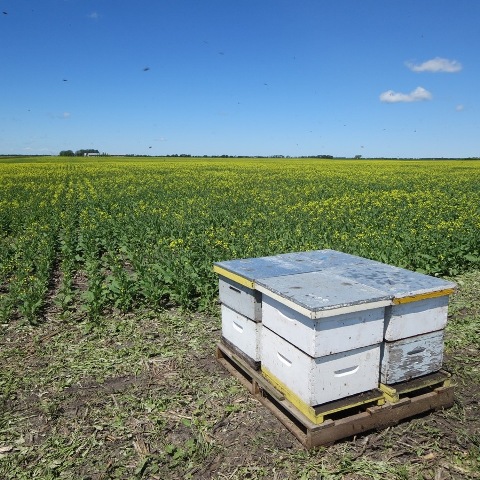 Pollinators are a critical part of our agro-ecosystem and without them we would produce less crops in Manitoba. They may not easily be seen at times, or we may not always recognize them, but they’re out there pollinating flowers and increasing yields. Even some crops that may produce acceptable yields in the absence of pollinators, such as canola, may produce much better yields with good pollination. Insects make up a significant portion of the pollinators in most areas. For these reasons, this sheet discusses how to protect and support insect pollinators.
Pollinators are a critical part of our agro-ecosystem and without them we would produce less crops in Manitoba. They may not easily be seen at times, or we may not always recognize them, but they’re out there pollinating flowers and increasing yields. Even some crops that may produce acceptable yields in the absence of pollinators, such as canola, may produce much better yields with good pollination. Insects make up a significant portion of the pollinators in most areas. For these reasons, this sheet discusses how to protect and support insect pollinators.Right: Honey bee hives next to a canola field. Honey bees and many other insect pollinators are a critical part of our agro-ecosystem.
What is a Pollinator?
Pollinators are flower visitors that transfer pollen from the male anther to the female stigma of flowers of the same species. They pollinate while they collect food in the form of pollen and nectar. Pollinators include insects such as bees, flies, butterflies, wasps, moths, beetles and others. They’re often native and wild, but they may also be managed like bees that are kept by a beekeeper. Bees are often considered the most important pollinators in many ecosystems because they visit many flowers due to their reliance on nectar and pollen for both adult and larval nutrition, and their activity often results in pollination. Collectively, non-bee pollinators are also very important (1). Not all bees or flower visitors are effective pollinators, and you can’t make an insect pollinate, but you can certainly help create an environment that encourages such activity.
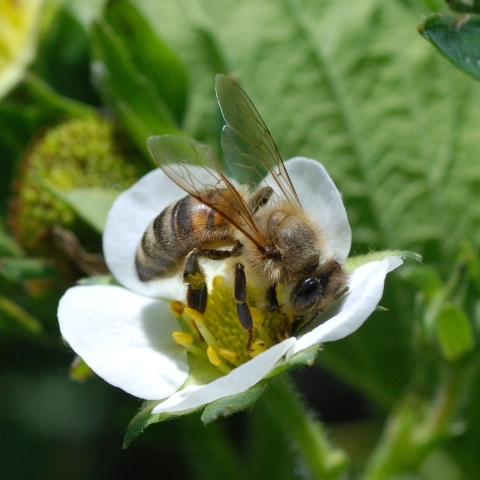 |
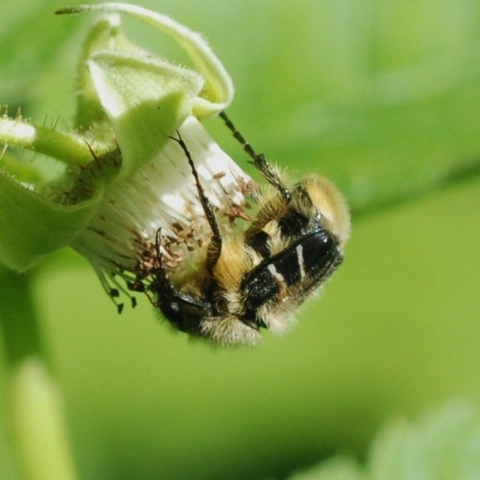 |
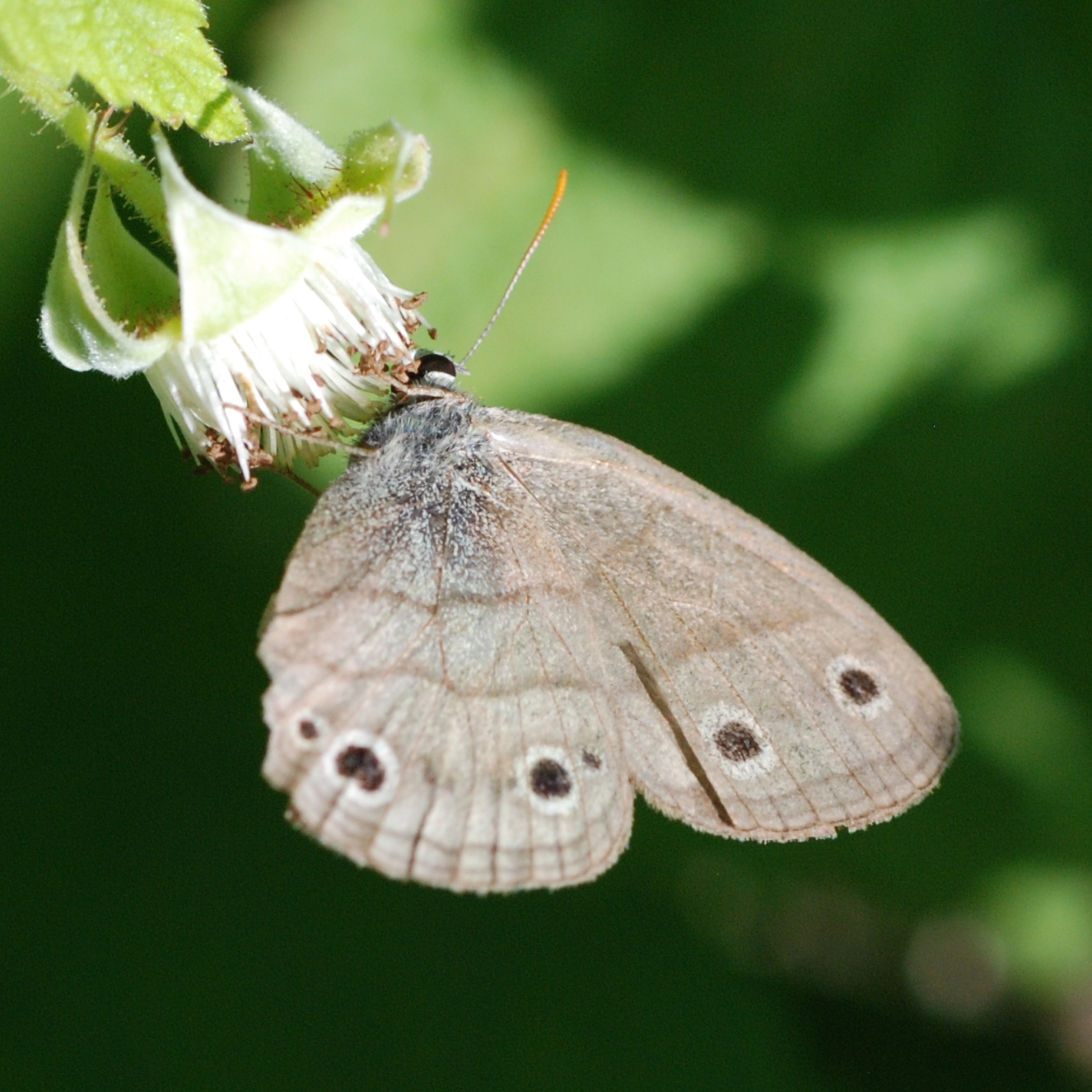 |
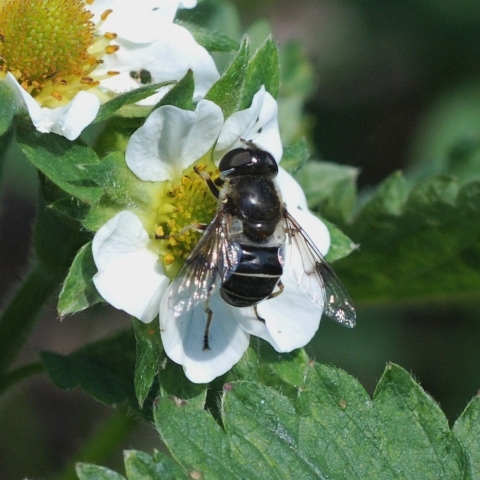 |
|---|
Risks to Pollinators
In our cropping systems, the greatest risks to pollinators are probably forage and nesting habitat loss and pesticide usage (insecticide, fungicide and herbicide). While the impact of habitat loss is more straight forward, the risk of pesticides to insect pollinators, particularly the honey bee, has been studied around the world for decades. Yet it’s important to note that these studies often are not specifically conducted under Manitoban or even Canadian conditions, and our understanding of these complex relationships is not complete.
The risk that an insecticide poses to pollinators varies greatly between products, and such risk should be considered when any field that has flowering crops or flowering weeds is to be sprayed. Because an insecticide has a decreased risk to pollinators such as bees does not necessarily make it less effective at controlling targeted pest insects. The mode of action of the insecticide can be one reason for insecticides being of less risk to bees. Additionally, because bees feed primarily on pollen and nectar, and many crop pests feed on vegetation or plant sap, there are some insecticides that when applied properly can be highly effective at controlling potential pests, but with reduced risk to bees and many pollinators. Fungicides are currently believed to have relatively low toxicity to honey bees on their own, but some fungicides have been found to have a negative impact on solitary bees (2,3).
Pesticide Labels and Risk Warnings
All levels of government have taken steps to try to protect pollinators. Pesticide product labels are approved by Health Canada and users are required to follow the label; “the label is the law”, as they say. The label for any pesticide registered in Canada can be found at: http://pr-rp.hc-sc.gc.ca/ls-re/index-eng.php. These labels will have a section titled “Environmental Hazards”. Here it usually states whether a pesticide is safe to apply to flowering plants, should only be applied to flowering plants when bees are not foraging (such as in the evening), or should not be applied to flowering plants. Where such wording is absent and there is flexibility in application, the following is generally recommended:
Recommendations for Pesticide Application (Guidelines Only):
Monitoring and Thresholds - Avoid unnecessary pesticide usage. Monitor insect pest levels in the field, using a sweep net or insect trap for example, and use pest threshold numbers to help minimize insecticide usage.
Plant Stage at Application - Avoid spraying foliar insecticides when there is bloom in the field, when possible. Any flowers in a field, whether crop or weed, can attract pollinators. For wild bees that forage and nest near a cropped field, insecticide applications can be a risk before and after field bloom as well (2), which emphasizes the value of monitoring and using thresholds to minimize insecticide usage where possible.
Application Timing - Apply foliar insecticide when bees and other pollinators are least active, which is usually when the sun is down. Although there are nocturnal pollinators on some crops, many pollinators are most active in fields during the day when the sun is up. Some crops only bloom part of the day, for example in the morning, and when not in bloom, pollinator activity may be significantly reduced. Different products or formulations can have different residual activity which can also vary with dosage and ambient conditions. For example, pesticide residual activity generally lasts longer in cooler weather. Avoid applying insecticides when unusually low temperatures or dew are forecast following treatment as residues typically remain toxic to bees longer under these conditions.
Application Method and Conditions - Avoid drifting of foliar and seed-treatment insecticide. Factors such as weather conditions, product type, applicator method, and others can affect the drift risk during application. Where possible, such factors should be mitigated. For example, foliar insecticide should be applied on calm days, and seeders of insecticide-treated seed should exhaust into the ground if possible. If seeding equipment may potentially generate dust, controlling flowering weeds in the field prior to seeding may reduce pollinators being attracted to the field.
Pesticide Options - Sometimes multiple products or formulations are registered for the same insect pest. If so, it may be possible to choose one that is safer to bees and other pollinators. In general, dusts are more hazardous to bees than sprays. Wettable powders are more hazardous than emulsifiable concentrates or water-soluble formulations. It’s important to note that “safer to bees” does not necessarily mean less effective pest control. The annual Guide to Field Crop Protection, by Manitoba Agriculture, provides a list of commonly used insecticides in field crops, and their risk to pollinators. The Western Committee on Crop Pests also has a table of hazard ratings of insecticides to bees, see: http://www.westernforum.org/WCCP%20Guidelines.html.
Communication with beekeepers - If hives are in the area, communicate with the beekeeper before applying foliar insecticide. Know the label and understand the risk before application. Honey bee hives may not always be visible from the road. New communications tools exist that can help connect parties and improve information sharing and cooperation. For example, BeeConnected (www.beeconnected.ca) is a website and mobile phone app that enables farmers and pesticide applicators to know of beehives within 5 km of a property or area to be sprayed, and notifies beekeepers of planned pesticide use. Letting the beekeeper know what foliar spray is being used and when can help the applicator and beekeeper avoid bee losses.
How to Support Pollinators?
Nesting of Wild Bees
Wild bees need nesting sites especially in the ground and in wood cavities. The majority of wild bees make their nest in the ground. These include many species of sweat bees (Lasioglossum), mining bees (Andrena), plasterer bees (Colletes), and others (4). Many other bees nest in cavities in wood such as trees or plant stems. These include masked bees (Hylaeus), small carpenter bees (Ceratina), and lesser mason-bees (Hoplitis). Some ground-nesting bees are known to live in sandy or loamy soils. The nests may be in natural unmanaged locations, fields, or even residential yards.
Making Nests to House Wild Bees
Nesting structures can be made to encourage localized pollinator activity. There are various ways to construct above-ground nests, but natural biodegradeable construction is generally preferred by the pollinator, better for the environment, and reduces longer-term disease build-up issues. Nests can be made as bundles or blocks. Keeping the constructed nest off the ground, such as by mounting it on a post, will minimize attack by ants and other non-flying enemies, and prevent extra moisture from seeping into the wood.
Bee nest bundles can be made of groups of hollow stems or straws, roughly 10 to 20 cm long, tied together. One end of each stem or straw should be blocked or closed, since bees will not use a tunnel which is open at both ends. Bee blocks are often made of pieces of untreated lumber with holes about 2.5 to 10 mm diameter and 4 to 7 cm deep drilled into them. Several holes can be drilled in one block of wood.
 |
 |
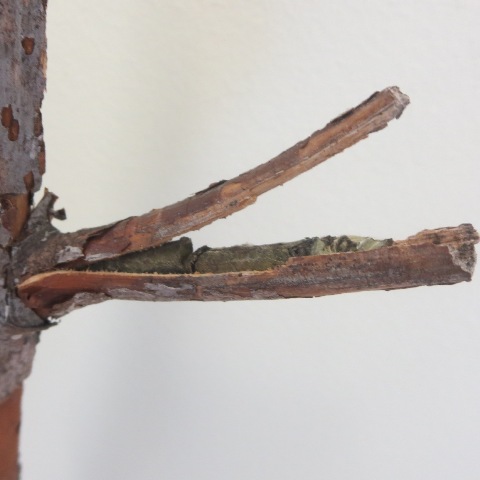 |
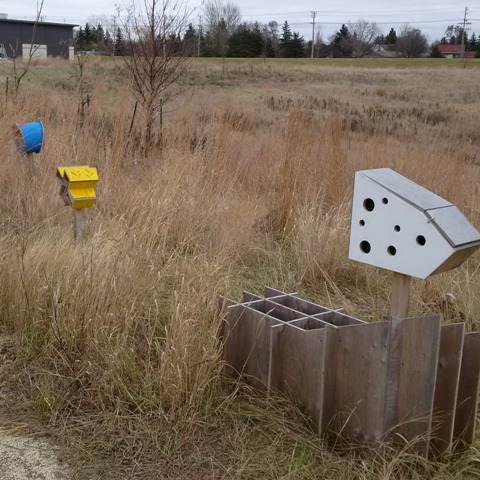 |
|---|
Impact of Tillage and Burning on Pollinators
Tillage of the soil that houses ground-nesting bees destroys the nests and potentially the adults and their offspring; therefore leave some areas untilled if possible. Untilled land may include hedgerows or shelterbelts, field margins and corners, river or stream banks. Generally speaking, mowing has less of an impact on wild ground-nesting bees than burning, and burning less of an impact than tilling. Bees and other pollinators can often survive infrequent, smaller area, low intensity burns, and such burns can also improve pollinator habitat in the longer term (5).
Management of Non-Cropped Areas to Encourage Pollinators
Appropriate management of non-cropped areas to encourage wild pollinators may prove to be a cost-effective means of maximizing crop yield. Hedgerows and field margins with trees and shrubs, flowering vegetation, well-drained soil, a variety of pithy stems, snag trees, or dead branches, provide forage, habitat, and refuge for wild pollinators and bees. Hedgerows on the north side of a field can provide shelter from prevailing winds for pollinators on that field. Where a hedgerow is restored within an intensive agricultural landscape, the result has been found to be positive for more specialised and less mobile insect pollinators (6). Larger bees tend to be more mobile and able to fly further (6), and so for these bees, the broader regional habitat is even more important than the field margin habitat (2). For row crops, some pollinators tend to move further down rows than across rows.
Floral Diversity and Pollinators
A habitat with an abundance of diverse floral sources is ideal for insect pollinators like bees. A wider variety of flowering plants generally supports a wider variety of bees, and early, mid and late season bloom promotes more pollinator activity. Many beneficial parasites of crop pests also feed on nectar as adults, so floral diversity can also enhance biological control. Pollinators also need fresh, clean water which can come from rain, dew, or a nearby stream.
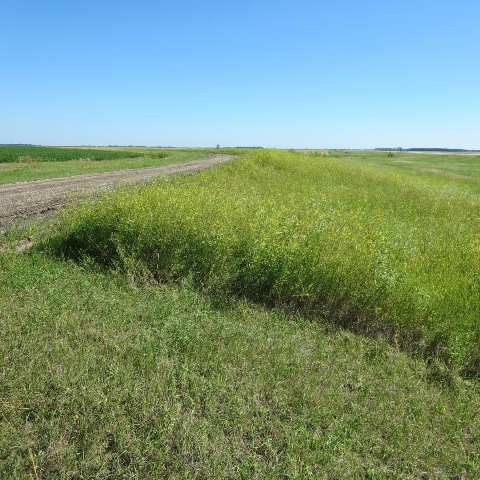
Public areas can be extensive and very suitable for pollinators. Roadside margins and ditches with forage vegetation and nesting habitat can support significant activity, which can benefit nearby cropping systems and other areas. Locations that are open to the sun generally are better habitat for flowering plants and pollinators. While maintaining a variety of flowering plants is encouraged, some weed are listed as noxious weeds and their management may fall under government legislation.
Right: Roadside flowers, like sweet clover and other vegetation, can support a significant pollinator population.
The monarch butterfly is a pollinator of wild plants and some crops. They’re also very recognizable and a favourite of many gardeners and landowners. Larvae feed on milkweed species.
Above: (L) An adult monarch butterfly. (R) A monarch butterfly caterpillar on a milkweed plant.
 |
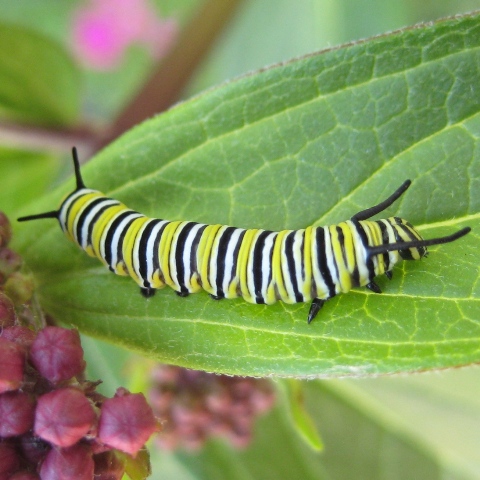 |
|---|
Problem or Nuisance Situations
The focus of this summary is on protecting and supporting pollinators, a critical part of our agro-ecosystem. However, for some there can be issues and a reminder that insect pollinators are resourceful and present in a healthy environment. Bees, in particular, are usually busy “in the background” and not really noticed, but the following can be problematic:
- Bees nesting or swarming in or near a residence or other buildings;
- Bees stinging or biting when they become defensive or with accidental contact;
- Bees cutting out pieces of leaves or petals from plants.
If you have ground-nesting bees in an undesirable location, repeatedly dousing the area with water may be enough to persuade them to move. For situations where honey bees have swarmed and are clustered in an undesirable location, contact your local agriculture office or a beekeeper to see if the swarm can be safely removed.
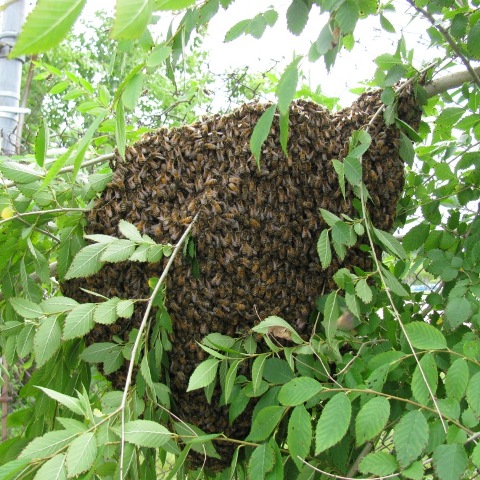 |
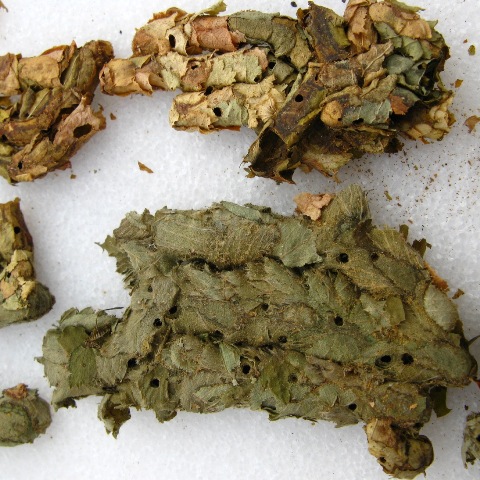 |
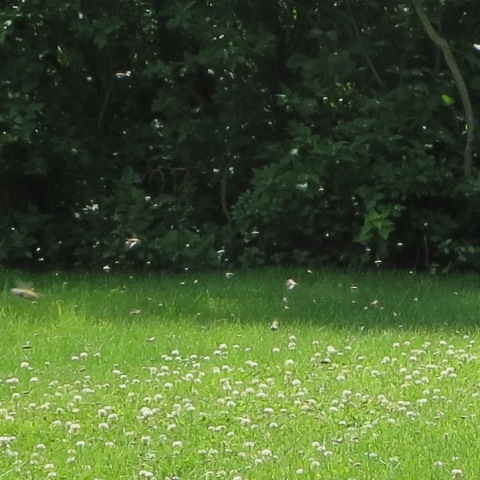 |
|---|
References:
(1) Radera, R., Bartomeus, I., Garibaldi, L.A., et al. 2016. Non-bee insects are important contributors to global crop pollination. Proceedings of the National Academy of Sciences 113(1): 146-151.
(2) Park M.G., Blitzer E.J., Gibbs J., Losey J.E., and B. N. Danforth. 2015 Negative effects of pesticides on wild bee communities can be buffered by landscape context. Proc. R. Soc. B 282: 20150299.
(3) Artz D.R. and T.L. Pitts-Singer (2015) Effects of Fungicide and Adjuvant Sprays on Nesting Behavior in Two Managed Solitary Bees, Osmia lignaria and Megachile rotundata. PLoS ONE 10(8): e0135688. doi:10.1371/journal.pone.0135688
(4) Sheffield, C. S., S. D. Frier, and S. Dumesh. 2014. The Bees (Hymenoptera: Apoidea, Apiformes) of the Prairies Ecozone, with Comparisons to other Grasslands of Canada. In Arthropods of Canadian Grasslands (Volume 4): Biodiversity and Systematics Part 2. Edited by D. J. Giberson and H. A. Cárcamo. Biological Survey of Canada. pp. 427-467. © 2014 Biological Survey of Canada.
(5) U.S. Department of Agriculture and U.S. Department of Interior. 2015. Pollinator-Friendly Best Management Practices for Federal Lands. 52 pp.
(6) Kremen, C. and L. K. M’Gonigle. 2015. Small-scale restoration in intensive agricultural landscapes supports more specialized and less mobile pollinator species. Journal of Applied Ecology. 52, 602–610 doi: 10.1111/1365-2664.12418

